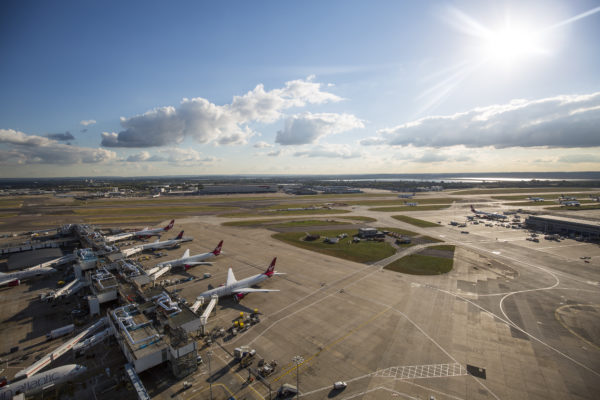Heathrow third runway could leave 1.6m people with ‘constant noise’
An analysis of documents looking at potential flight paths for the new runway suggests that a huge number of Londoners could face as many 47 noisy flights every hour

A third runway at Heathrow could leave 1.6m people at risk of up to 47 noisy flights an hour, according to new research by Unearthed.
Documents published by Heathrow earlier this year outline the possible flight paths airport officials are considering for the new runway. By overlaying these potential flight paths with population data, Unearthed found that more than 11m people live within areas identified as at risk of flights at levels above 65 decibels. That volume is comparable to the noise level in a busy office.
That 11m figure is expected to be significantly reduced when officials settle on final paths. However, experts have told Unearthed that the 1.6m people living in sections of the proposed flight paths closest to the airport are almost certain to be overflown and to experience noise levels at or above 65 decibels.
The Heathrow documents explicitly detail how these inner areas close to the airport could be overflown by up to 47 flights per hour, as the various flight paths become more concentrated closer to the runway. For the 1.6m people in these areas, experts say, the noise disturbance could be near constant.
Heathrow’s consultation does not make it possible to calculate exactly how many noisy flights people would experience, because the airport has not decided on final flight paths which, it argues “will not cover the full width of the envelope”.
In response to Unearthed’s analysis, Conservative party MP Greg Hands, who resigned from the Cabinet over Heathrow expansion, said that it is “hard to ignore” the noise that will be brought by expansion. He added: “It also seems to confirm that many more Londoners will experience disturbance under an expanded Heathrow, including those who are not currently overflown but may be, following expansion.”
Green party MP Caroline Lucas said the research revealed the “unacceptable” levels of noise that people could be exposed to. “It’s vital that Heathrow is not allowed to expand and not allowed to further damage our environment or people’s lives.”
The news comes after groups including Mayor of London, local councils, Friends of the Earth and Greenpeace failed in their High Court bid to block the building of the third runway on climate and pollution grounds.
In January, Heathrow released consultation documents which included 18 maps of the potential flight pathways following expansion. These included different bands according to height for flight arrivals and departures and the noise levels associated with each.
While the airport provided tools for individual constituents to find out how their home might be affected by the flight maps, no population figures were given for each map or for the total area covered.
This research shows there are very few areas within a 30km radius of the airport that won’t have constant noise from Heathrow
In Unearthed’s analysis, the different maps – so called ‘design envelopes’ – were compiled together and population numbers were calculated within the different areas.
Heathrow rejected Unearthed’s findings, with a spokesperson calling them “misleading” and saying “they are based on the total number of people within each design envelope. These design envelopes cover broad areas and the final flight paths will not be spread across the full width of the envelope.”
The Heathrow spokesperson added that the consultation process was designed to understand which areas are the most noise-sensitive and that options will be explored to give residents respite from flight noise at different times of the day.
The Heathrow consultation says that many ‘design envelopes’ are likely to have two or three flight pathways running through them. But separately it also notes that in the areas closest to the airport the flight paths will need to be lined up with the runway, meaning there is “limited flexibility” for them to spread out.
Colin Stanbury, a noise consultant who worked with local councils on their high court challenge, said: “This research shows there are very few areas within a 30km radius of the airport that won’t have constant, all day noise from Heathrow.”
Campaigners argue that the number of people who will be adversely impacted by Heathrow expansion has been played down by the government and the airport.
Neither has published numbers on how many people will be affected, and both claim that careful planning and improved aircraft technology will ensure quieter overall operations – even after expansion adds 260,000 flights a year to its current 480,000 capacity.
In March, the Sunday Times reported that the Department for Transport blocked plans by Heathrow to launch a publicity campaign telling 13m people they could face extra noise if the third runway is built; arguing in an internal memo that it was “likely to create significant public debate and unnecessary controversy” ahead of a parliamentary vote.
A separate report in the Guardian suggested that over two million people would be affected by additional aircraft noise after a third runway is built, but this was before Heathrow had published any of their own work on the future flight pathways.
John Stewart, chair of the airport campaign group HACAN, noted the possibility that the “huge” numbers of people living in flight paths could be lower, but that the scale will be unknown until more work is done. The specific flight pathways will not be consulted on by Heathrow until 2020 at the earliest.
“The people who will be worst hit by a third runway will be those directly under its new approach and departure flight paths,” he said.
Friends of the Earth, which challenged the third runway plans on climate change grounds, has announced it will appeal the judicial review decision.

